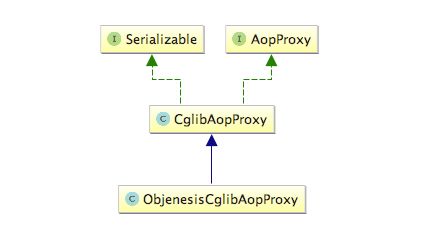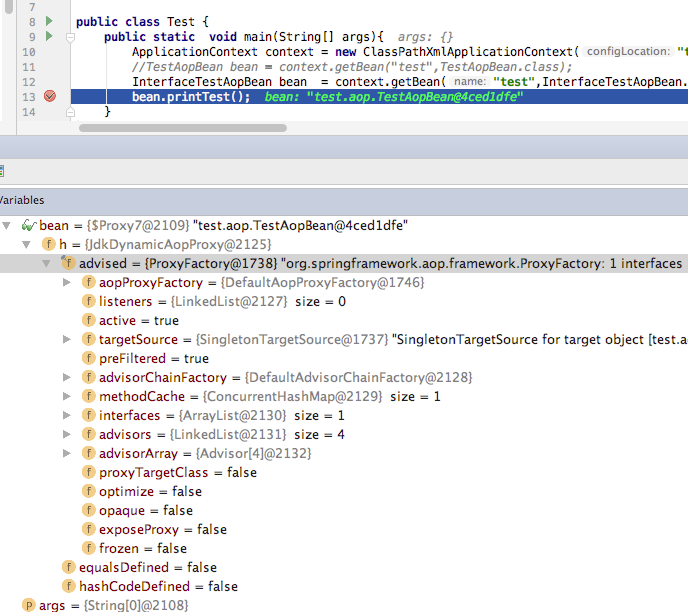一、创建代理
接上文,在AbstractAutoProxyCreator的wrapIfNecessary方法中,拿到全部advisors后,需要创建目标Bean的代理Bean:
// 拿到所有Advisors
Object[] specificInterceptors = getAdvicesAndAdvisorsForBean(bean.getClass(), beanName, null);
if (specificInterceptors != DO_NOT_PROXY) {
this.advisedBeans.put(cacheKey, Boolean.TRUE);
// 创建代理
Object proxy = createProxy(
bean.getClass(), beanName, specificInterceptors, new SingletonTargetSource(bean));
this.proxyTypes.put(cacheKey, proxy.getClass());
return proxy;
}createProxy源码如下:
// 为bean创建 AOP代理
protected Object createProxy(
Class<?> beanClass, String beanName, Object[] specificInterceptors, TargetSource targetSource) {
if (this.beanFactory instanceof ConfigurableListableBeanFactory) {
// 给BeanDefinition设置ORIGINAL_TARGET_CLASS_ATTRIBUTE属性为 beanClass
AutoProxyUtils.exposeTargetClass((ConfigurableListableBeanFactory) this.beanFactory, beanName, beanClass);
}
// 代理的工厂类
ProxyFactory proxyFactory = new ProxyFactory();
// 设置一些属性
proxyFactory.copyFrom(this);
// 若proxyTargetClass为true时,直接使用CGlib
if (!proxyFactory.isProxyTargetClass()) {
// 若proxyTargetClass为false时,决定给定的bean是否被其目标class代理还是接口,
// 也就是是否使用CGLIB,查看BeanDefinition的PRESERVE_TARGET_CLASS_ATTRIBUTE属性
if (shouldProxyTargetClass(beanClass, beanName)) {
proxyFactory.setProxyTargetClass(true);
}
else {
// 拿到beanClass的所有接口,若无接口,设置proxyTargetClass为true
// 若有,则添加接口到proxyFactory里
evaluateProxyInterfaces(beanClass, proxyFactory);
}
}
// 将一些common interceptor放入advisors中,把Advice转换为Advisor
Advisor[] advisors = buildAdvisors(beanName, specificInterceptors);
for (Advisor advisor : advisors) {
proxyFactory.addAdvisor(advisor);
}
proxyFactory.setTargetSource(targetSource);
//
customizeProxyFactory(proxyFactory);
// 标识代理是否应该被frozen?
proxyFactory.setFrozen(this.freezeProxy);
if (advisorsPreFiltered()) {
proxyFactory.setPreFiltered(true);
}
// 创建代理
return proxyFactory.getProxy(getProxyClassLoader());
}
在上述源码中,关键点在于对proxy-target-class属性的处理,决定了后续使用CGLIB还是JDK动态代理来创建代理类。
核心在于 ProxyFactory ----- getProxy方法:
/**
* Create a new proxy according to the settings in this factory.
* <p>Can be called repeatedly. Effect will vary if we've added
* or removed interfaces. Can add and remove interceptors.
* <p>Uses the given class loader (if necessary for proxy creation).
* @param classLoader the class loader to create the proxy with
* (or {@code null} for the low-level proxy facility's default)
* @return the proxy object
*/
public Object getProxy(ClassLoader classLoader) {
// 创建出不同的AopProxy ,ObjenesisCglibAopProxy还是JdkDynamicAopProxy
return createAopProxy().getProxy(classLoader);
}
DefaultAopProxyFactory:
// 创建AopProxy ,决定用CGlib还是 JDK动态代理
public AopProxy createAopProxy(AdvisedSupport config) throws AopConfigException {
// optimize属性, proxy-target-class属性,目标类只有SpringProxy接口,目标类没有接口
// 只要其一成立
if (config.isOptimize() || config.isProxyTargetClass() || hasNoUserSuppliedProxyInterfaces(config)) {
Class<?> targetClass = config.getTargetClass();
if (targetClass == null) {
throw new AopConfigException("TargetSource cannot determine target class: " +
"Either an interface or a target is required for proxy creation.");
}
// 目标是接口,或者 class是由代理类动态通过getProxyClass方法 或者 newProxyInstance方法
// 产生的
if (targetClass.isInterface() || Proxy.isProxyClass(targetClass)) {
return new JdkDynamicAopProxy(config);
}
// 返回CGLIB代理
return new ObjenesisCglibAopProxy(config);
}
else {
// 返回Jdk动态代理
return new JdkDynamicAopProxy(config);
}
}在本例中,由于目标类TestAop没有实现任何接口,所以使用ObjenesisCglibAopProxy作为代理类。
二、CglibAopProxy- CGLIB代理-----创建与调用
ObjenesisCglibAopProxy的类图如下:

ObjenesisCglibAopProxy是CglibAopProxy的扩展,不调用类的构造函数就可以创建代理实例,在其中重写了类的createProxyClassAndInstance方法。上文提到 创建Proxy成功后,会调用该Proxy的getProxy方法,此刻调用的是CglibAopProxy的getProxy():
@Override
public Object getProxy(ClassLoader classLoader) {
if (logger.isDebugEnabled()) {
logger.debug("Creating CGLIB proxy: target source is " + this.advised.getTargetSource());
}
try {
Class<?> rootClass = this.advised.getTargetClass();
Assert.state(rootClass != null, "Target class must be available for creating a CGLIB proxy");
Class<?> proxySuperClass = rootClass;
// 若rootClass是一个Cglib产生的类,将其父类的接口放入advised中
if (ClassUtils.isCglibProxyClass(rootClass)) {
proxySuperClass = rootClass.getSuperclass();
Class<?>[] additionalInterfaces = rootClass.getInterfaces();
for (Class<?> additionalInterface : additionalInterfaces) {
this.advised.addInterface(additionalInterface);
}
}
// 验证class类,在此处检查了当前类和其父类的pointcut方法,
// 方法不能是非静态final的,且不能 是不同ClassLoader包可见的
// 打印不能被代理的日志
validateClassIfNecessary(proxySuperClass, classLoader);
// 配置CGLIB的Enhancer
Enhancer enhancer = createEnhancer();
if (classLoader != null) {
enhancer.setClassLoader(classLoader);
if (classLoader instanceof SmartClassLoader &&
((SmartClassLoader) classLoader).isClassReloadable(proxySuperClass)) {
enhancer.setUseCache(false);
}
}
enhancer.setSuperclass(proxySuperClass);
// 得到最终的接口的集合
enhancer.setInterfaces(AopProxyUtils.completeProxiedInterfaces(this.advised));
enhancer.setNamingPolicy(SpringNamingPolicy.INSTANCE);
enhancer.setStrategy(new ClassLoaderAwareUndeclaredThrowableStrategy(classLoader));
// 得到所有CallBack
Callback[] callbacks = getCallbacks(rootClass);
Class<?>[] types = new Class<?>[callbacks.length];
for (int x = 0; x < types.length; x++) {
types[x] = callbacks[x].getClass();
}
// fixedInterceptorMap 只在此刻被注入
// 用于控制哪些方法会走callBack
enhancer.setCallbackFilter(new ProxyCallbackFilter(
this.advised.getConfigurationOnlyCopy(), this.fixedInterceptorMap, this.fixedInterceptorOffset));
enhancer.setCallbackTypes(types);
// 创建代理类实例
return createProxyClassAndInstance(enhancer, callbacks);
}
catch (CodeGenerationException ex) {
throw new AopConfigException("Could not generate CGLIB subclass of class [" +
this.advised.getTargetClass() + "]: " +
"Common causes of this problem include using a final class or a non-visible class",
ex);
}
catch (IllegalArgumentException ex) {
throw new AopConfigException("Could not generate CGLIB subclass of class [" +
this.advised.getTargetClass() + "]: " +
"Common causes of this problem include using a final class or a non-visible class",
ex);
}
catch (Throwable ex) {
// TargetSource.getTarget() failed
throw new AopConfigException("Unexpected AOP exception", ex);
}
}对于CGlib来说,设置callback非常关键,callback拦截函数的调用,callbackFilter决定拦截哪些函数。
CglibAopProxy---getCallbacks
// 得到当前class所有的callbacks
private Callback[] getCallbacks(Class<?> rootClass) throws Exception {
// Parameters used for optimisation choices...
boolean exposeProxy = this.advised.isExposeProxy();
boolean isFrozen = this.advised.isFrozen();
boolean isStatic = this.advised.getTargetSource().isStatic();
// Choose an "aop" interceptor (used for AOP calls).
// 实现了CGlib需要的MethodInterceptor接口
Callback aopInterceptor = new DynamicAdvisedInterceptor(this.advised);
// Choose a "straight to target" interceptor. (used for calls that are
// unadvised but can return this). May be required to expose the proxy.
Callback targetInterceptor;
// 判断需不需要暴露代理,生成未被增强方法的 interceptor
if (exposeProxy) {
targetInterceptor = isStatic ?
new StaticUnadvisedExposedInterceptor(this.advised.getTargetSource().getTarget()) :
new DynamicUnadvisedExposedInterceptor(this.advised.getTargetSource());
}
else {
targetInterceptor = isStatic ?
new StaticUnadvisedInterceptor(this.advised.getTargetSource().getTarget()) :
new DynamicUnadvisedInterceptor(this.advised.getTargetSource());
}
// Choose a "direct to target" dispatcher (used for
// unadvised calls to static targets that cannot return this).
// 用于不能返回this的interceptor
Callback targetDispatcher = isStatic ?
new StaticDispatcher(this.advised.getTargetSource().getTarget()) : new SerializableNoOp();
// 上篇文章截图的7个interceptor就是此处产生的
Callback[] mainCallbacks = new Callback[] {
aopInterceptor, // for normal advice
targetInterceptor, // invoke target without considering advice, if optimized
new SerializableNoOp(), // no override for methods mapped to this
targetDispatcher, this.advisedDispatcher,
new EqualsInterceptor(this.advised),
new HashCodeInterceptor(this.advised)
};
Callback[] callbacks;
// If the target is a static one and the advice chain is frozen,
// then we can make some optimisations by sending the AOP calls
// direct to the target using the fixed chain for that method.
// 如果Advised是静态的,并且advice chain 是frozen的
// 做了一些优化
if (isStatic && isFrozen) {
Method[] methods = rootClass.getMethods();
Callback[] fixedCallbacks = new Callback[methods.length];
this.fixedInterceptorMap = new HashMap<String, Integer>(methods.length);
// TODO: small memory optimisation here (can skip creation for methods with no advice)
for (int x = 0; x < methods.length; x++) {
// 得到目标方法的Adviced 拦截链
List<Object> chain = this.advised.getInterceptorsAndDynamicInterceptionAdvice(methods[x], rootClass);
fixedCallbacks[x] = new FixedChainStaticTargetInterceptor(
chain, this.advised.getTargetSource().getTarget(), this.advised.getTargetClass());
this.fixedInterceptorMap.put(methods[x].toString(), x);
}
// Now copy both the callbacks from mainCallbacks
// and fixedCallbacks into the callbacks array.
callbacks = new Callback[mainCallbacks.length + fixedCallbacks.length];
System.arraycopy(mainCallbacks, 0, callbacks, 0, mainCallbacks.length);
System.arraycopy(fixedCallbacks, 0, callbacks, mainCallbacks.length, fixedCallbacks.length);
this.fixedInterceptorOffset = mainCallbacks.length;
}
else {
callbacks = mainCallbacks;
}
return callbacks;
}进入CallBack里,优先实例化DynamicAdvisedInterceptor :
/**
* General purpose AOP callback. Used when the target is dynamic or when the
* proxy is not frozen.
*/
private static class DynamicAdvisedInterceptor implements MethodInterceptor, Serializable {
private final AdvisedSupport advised;
public DynamicAdvisedInterceptor(AdvisedSupport advised) {
this.advised = advised;
}
@Override
public Object intercept(Object proxy, Method method, Object[] args, MethodProxy methodProxy) throws Throwable {
Object oldProxy = null;
boolean setProxyContext = false;
Class<?> targetClass = null;
Object target = null;
try {
if (this.advised.exposeProxy) {
// Make invocation available if necessary.
oldProxy = AopContext.setCurrentProxy(proxy);
setProxyContext = true;
}
// May be null. Get as late as possible to minimize the time we
// "own" the target, in case it comes from a pool...
target = getTarget();
if (target != null) {
targetClass = target.getClass();
}
// 得到该方法的 拦截链
List<Object> chain = this.advised.getInterceptorsAndDynamicInterceptionAdvice(method, targetClass);
Object retVal;
// Check whether we only have one InvokerInterceptor: that is,
// no real advice, but just reflective invocation of the target.
// 若方法不需要增强,直接反射调用
if (chain.isEmpty() && Modifier.isPublic(method.getModifiers())) {
// We can skip creating a MethodInvocation: just invoke the target directly.
// Note that the final invoker must be an InvokerInterceptor, so we know
// it does nothing but a reflective operation on the target, and no hot
// swapping or fancy proxying.
Object[] argsToUse = AopProxyUtils.adaptArgumentsIfNecessary(method, args);
retVal = methodProxy.invoke(target, argsToUse);
}
else {
// We need to create a method invocation...
// 职责链调用方法
retVal = new CglibMethodInvocation(proxy, target, method, args, targetClass, chain, methodProxy).proceed();
}
// 处理返回值
retVal = processReturnType(proxy, target, method, retVal);
return retVal;
}
finally {
if (target != null) {
releaseTarget(target);
}
if (setProxyContext) {
// Restore old proxy.
AopContext.setCurrentProxy(oldProxy);
}
}
}
@Override
public boolean equals(Object other) {
return (this == other ||
(other instanceof DynamicAdvisedInterceptor &&
this.advised.equals(((DynamicAdvisedInterceptor) other).advised)));
}
/**
* CGLIB uses this to drive proxy creation.
*/
@Override
public int hashCode() {
return this.advised.hashCode();
}
protected Object getTarget() throws Exception {
return this.advised.getTargetSource().getTarget();
}
protected void releaseTarget(Object target) throws Exception {
this.advised.getTargetSource().releaseTarget(target);
}
}
CglibAopProxy:
protected Object createProxyClassAndInstance(Enhancer enhancer, Callback[] callbacks) {
enhancer.setInterceptDuringConstruction(false);
enhancer.setCallbacks(callbacks);
// 调用Enhancer的create方法,创建代理
return (this.constructorArgs != null ?
enhancer.create(this.constructorArgTypes, this.constructorArgs) :
enhancer.create());
}使用CGlib产生了代理类,至此返回代理类。(关于CGlib的原理有机会写篇博客分析一下)
三、JDK动态代理 --创建与调用
为了能够使用JDK动态代理,根据上文当目标target 实现一个或多个接口时,Spring AOP会选用JDK动态代理,所以对code做如下修改:
添加接口 InterfaceTestAopBean:
public interface InterfaceTestAopBean {
public String getTestStr();
public void setTestStr(String testStr);
public void printTest();
}
TestAopBean:
public class TestAopBean implements InterfaceTestAopBean{...}
Test:
public static void main(String[] args){
ApplicationContext context = new ClassPathXmlApplicationContext("test/aop/spring-aop-config.xml");
//TestAopBean bean = context.getBean("test",TestAopBean.class);
// 使用接口
InterfaceTestAopBean bean = context.getBean("test",InterfaceTestAopBean.class);
bean.printTest();
}运行代码:

分析源码可知:
DefaultAopProxyFactory----createAopProxy 里产生了分支,使用JdkDynamicAopProxy:
@Override
public AopProxy createAopProxy(AdvisedSupport config) throws AopConfigException {
// proxy-target-class 因为有接口未被设置为true
if (config.isOptimize() || config.isProxyTargetClass() || hasNoUserSuppliedProxyInterfaces(config)) {
Class<?> targetClass = config.getTargetClass();
if (targetClass == null) {
throw new AopConfigException("TargetSource cannot determine target class: " +
"Either an interface or a target is required for proxy creation.");
}
if (targetClass.isInterface() || Proxy.isProxyClass(targetClass)) {
return new JdkDynamicAopProxy(config);
}
return new ObjenesisCglibAopProxy(config);
}
else {
// 返回JDK动态代理
return new JdkDynamicAopProxy(config);
}
}之后,调用AopProxy的getProxy方法,即JdkDynamicAopProxy---getProxy:
@Override
public Object getProxy(ClassLoader classLoader) {
if (logger.isDebugEnabled()) {
logger.debug("Creating JDK dynamic proxy: target source is " + this.advised.getTargetSource());
}
// 得到需要被AOP代理的所有接口
Class<?>[] proxiedInterfaces = AopProxyUtils.completeProxiedInterfaces(this.advised, true);
// 找到接口中所有equals与hashcode方法
findDefinedEqualsAndHashCodeMethods(proxiedInterfaces);
// 至此,返回一个JDK动态代理
return Proxy.newProxyInstance(classLoader, proxiedInterfaces, this);
}创建代理后,之后就是调用的过程,对于JDK动态代理来说,代理类实现InvocationHandler接口,实现invoke方法,方法调用会走代理类的invoke方法:
@Override //目标类的方法调用会进入此方法
public Object invoke(Object proxy, Method method, Object[] args) throws Throwable {
MethodInvocation invocation;
Object oldProxy = null;
boolean setProxyContext = false;
TargetSource targetSource = this.advised.targetSource;
Class<?> targetClass = null;
Object target = null;
try {
// 目标类没有实现equals方法,但当前调用方法是equals方法
if (!this.equalsDefined && AopUtils.isEqualsMethod(method)) {
// The target does not implement the equals(Object) method itself.
return equals(args[0]);
}
// 目标类没有实现hashcode方法,当前调用方法是hashcode方法
else if (!this.hashCodeDefined && AopUtils.isHashCodeMethod(method)) {
// The target does not implement the hashCode() method itself.
return hashCode();
}
else if (method.getDeclaringClass() == DecoratingProxy.class) {
// There is only getDecoratedClass() declared -> dispatch to proxy config.
return AopProxyUtils.ultimateTargetClass(this.advised);
}
else if (!this.advised.opaque && method.getDeclaringClass().isInterface() &&
method.getDeclaringClass().isAssignableFrom(Advised.class)) {
// Service invocations on ProxyConfig with the proxy config...
return AopUtils.invokeJoinpointUsingReflection(this.advised, method, args);
}
Object retVal;
if (this.advised.exposeProxy) {
// Make invocation available if necessary.
oldProxy = AopContext.setCurrentProxy(proxy);
setProxyContext = true;
}
// May be null. Get as late as possible to minimize the time we "own" the target,
// in case it comes from a pool.
target = targetSource.getTarget();
if (target != null) {
targetClass = target.getClass();
}
// Get the interception chain for this method.
// 得到方法的拦截链
List<Object> chain = this.advised.getInterceptorsAndDynamicInterceptionAdvice(method, targetClass);
// Check whether we have any advice. If we don't, we can fallback on direct
// reflective invocation of the target, and avoid creating a MethodInvocation.
if (chain.isEmpty()) {
// We can skip creating a MethodInvocation: just invoke the target directly
// Note that the final invoker must be an InvokerInterceptor so we know it does
// nothing but a reflective operation on the target, and no hot swapping or fancy proxying.
// 若没有Advice,直接反射调用方法
Object[] argsToUse = AopProxyUtils.adaptArgumentsIfNecessary(method, args);
retVal = AopUtils.invokeJoinpointUsingReflection(target, method, argsToUse);
}
else {
// We need to create a method invocation...
// 创建一个Method Invocation的职责链
invocation = new ReflectiveMethodInvocation(proxy, target, method, args, targetClass, chain);
// Proceed to the joinpoint through the interceptor chain.
// 职责链调用
retVal = invocation.proceed();
}
// Massage return value if necessary.
Class<?> returnType = method.getReturnType();
if (retVal != null && retVal == target &&
returnType != Object.class && returnType.isInstance(proxy) &&
!RawTargetAccess.class.isAssignableFrom(method.getDeclaringClass())) {
// Special case: it returned "this" and the return type of the method
// is type-compatible. Note that we can't help if the target sets
// a reference to itself in another returned object.
retVal = proxy;
}
else if (retVal == null && returnType != Void.TYPE && returnType.isPrimitive()) {
throw new AopInvocationException(
"Null return value from advice does not match primitive return type for: " + method);
}
return retVal;
}
finally {
if (target != null && !targetSource.isStatic()) {
// Must have come from TargetSource.
targetSource.releaseTarget(target);
}
if (setProxyContext) {
// Restore old proxy.
AopContext.setCurrentProxy(oldProxy);
}
}
}
本文分析了Spring AOP根据不同的情况返回 JDK动态代理 和 CGLIB代理,并分析了主要源码说明了代理创建和调用的过程。下篇开始进入 Spring MVC的源码分析阶段。





















 1405
1405











 被折叠的 条评论
为什么被折叠?
被折叠的 条评论
为什么被折叠?








